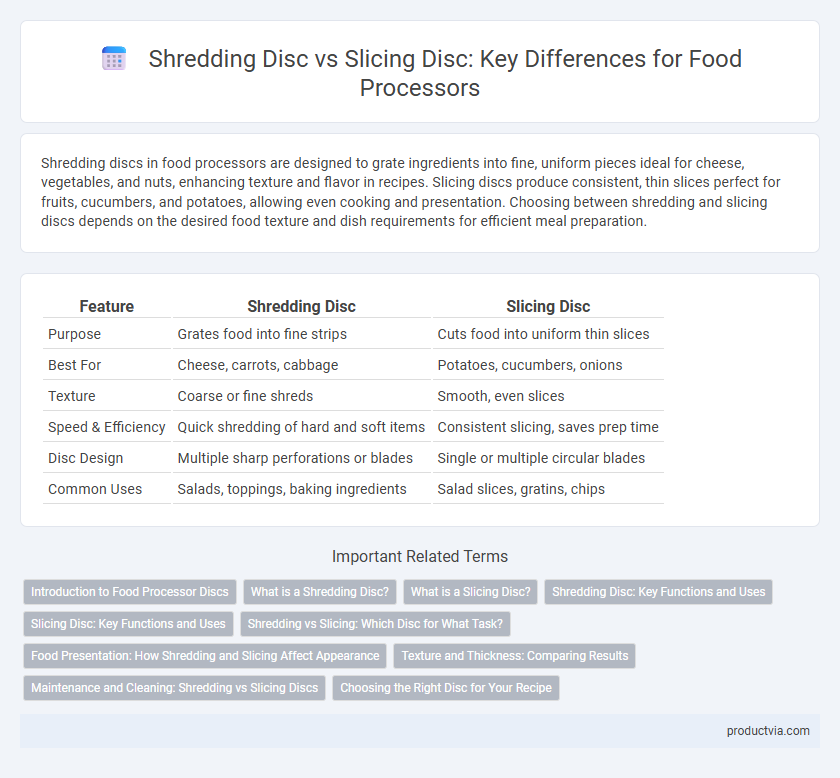Shredding discs in food processors are designed to grate ingredients into fine, uniform pieces ideal for cheese, vegetables, and nuts, enhancing texture and flavor in recipes. Slicing discs produce consistent, thin slices perfect for fruits, cucumbers, and potatoes, allowing even cooking and presentation. Choosing between shredding and slicing discs depends on the desired food texture and dish requirements for efficient meal preparation.
Table of Comparison
| Feature | Shredding Disc | Slicing Disc |
|---|---|---|
| Purpose | Grates food into fine strips | Cuts food into uniform thin slices |
| Best For | Cheese, carrots, cabbage | Potatoes, cucumbers, onions |
| Texture | Coarse or fine shreds | Smooth, even slices |
| Speed & Efficiency | Quick shredding of hard and soft items | Consistent slicing, saves prep time |
| Disc Design | Multiple sharp perforations or blades | Single or multiple circular blades |
| Common Uses | Salads, toppings, baking ingredients | Salad slices, gratins, chips |
Introduction to Food Processor Discs
Food processor discs are essential attachments designed to enhance versatility by enabling various cutting techniques, including shredding and slicing. The shredding disc features sharp, raised blades that efficiently shred vegetables, cheese, and nuts into fine, uniform pieces. In contrast, the slicing disc is equipped with a flat, sharp-edged blade that creates consistent, even slices, ideal for fruits, cucumbers, and potatoes.
What is a Shredding Disc?
A shredding disc in a food processor is designed with sharp, raised edges that quickly cut food into thin, uniform strips, ideal for shredding vegetables like carrots or cheese. This disc operates by forcing ingredients against the blade at high speed, producing consistent texture perfect for salads, garnishes, or recipes requiring fine shredding. Unlike slicing discs that create smooth, even slices, shredding discs emphasize texture and thickness, enhancing food presentation and cooking processes.
What is a Slicing Disc?
A slicing disc in a food processor is a specialized blade designed to cut vegetables, fruits, and other foods into uniform, thin slices quickly and efficiently. Unlike shredding discs that create fine, grated textures, slicing discs produce smooth, flat slices ideal for salads, gratins, and casseroles. This disc typically spins at high speed, using sharp, straight-edged blades to ensure precise and consistent thickness throughout the slicing process.
Shredding Disc: Key Functions and Uses
The shredding disc in a food processor is designed to grate vegetables, cheese, and nuts into fine, uniform pieces, making it ideal for recipes requiring quick and consistent shredding. It efficiently handles tasks like preparing coleslaw, shredding carrots for salads, or grating hard cheeses for toppings. Its sharp, perforated blades maximize speed and texture control, enhancing both preparation time and dish presentation.
Slicing Disc: Key Functions and Uses
The slicing disc in a food processor is designed to create uniform, thin slices of vegetables, fruits, and cheeses, enhancing presentation and cooking consistency. It is ideal for preparing ingredients for salads, gratins, and sandwiches, providing time-saving precision compared to manual slicing. This disc's adjustable thickness settings allow customization, making it versatile for various recipes and textures.
Shredding vs Slicing: Which Disc for What Task?
Shredding discs in food processors are ideal for tasks requiring finely grated textures, such as shredding cheese, vegetables like carrots, or cabbage for coleslaw. Slicing discs, on the other hand, create uniform, thin slices perfect for preparing salads, potatoes for chips, or fruits for garnishes. Choosing the right disc depends on the desired texture and recipe requirements, with shredding discs providing a grated consistency and slicing discs offering precise, even slices.
Food Presentation: How Shredding and Slicing Affect Appearance
Shredding discs create finely shredded textures that enhance the visual appeal of salads and garnishes, adding volume and a rustic charm to dishes. Slicing discs produce uniform, smooth slices that elevate presentation with clean, professional-looking cuts ideal for layered dishes or garnished platters. Choosing between shredding and slicing discs directly impacts the overall aesthetic, influencing both the texture contrast and plating style.
Texture and Thickness: Comparing Results
Shredding discs in food processors create coarser, more textured pieces ideal for toppings or salads, while slicing discs produce smooth, uniform slices perfect for layering or cooking evenly. The thickness from shredding discs tends to be variable and thicker, enhancing chewiness, whereas slicing discs offer adjustable thickness for precise, thin cuts. Texture differences influence the final dish's mouthfeel and cooking time, making each disc suitable for specific culinary tasks.
Maintenance and Cleaning: Shredding vs Slicing Discs
Shredding discs typically have more grooves and sharp edges, which can trap food particles and require thorough cleaning to prevent buildup and bacterial growth. Slicing discs usually have smoother surfaces and fewer crevices, making them easier to clean and maintain over time. Consistent cleaning with a brush and warm soapy water enhances the longevity and hygiene of both shredding and slicing discs in food processors.
Choosing the Right Disc for Your Recipe
Shredding discs create thin, uniform strips ideal for shredding cheese, cabbage, or carrots, enhancing texture in salads and slaws. Slicing discs produce even, flat slices perfect for cucumbers, potatoes, or apples, ensuring consistent thickness for cooking or presentation. Selecting the right disc depends on the recipe's texture requirements and desired food preparation speed.
Shredding disc vs Slicing disc for food processor Infographic

 productvia.com
productvia.com